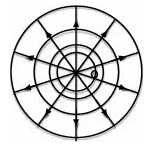Why are electric field lines perpendicular at a point on an equipotential surface of a conductor ?
If it were not so, the presence of a component of the field along the surface would violate its equipotential nature.
Detailed Answer :
In an equipotential surface, the potential for a point charge is given by As electric field lines point radially away from the charge, they are perpendicular to equipotential surface. If the electric field lines are not perpendicular to the surface of conductor, there exists a non-zero component of electric field along the surface of conductor where charges could not be at rest.

Detailed Answer :
In an equipotential surface, the potential for a point charge is given by As electric field lines point radially away from the charge, they are perpendicular to equipotential surface. If the electric field lines are not perpendicular to the surface of conductor, there exists a non-zero component of electric field along the surface of conductor where charges could not be at rest.

Why must electrostatic field at the surface of a charged conductor be normal to the surface at every point ? Give reason.
For any charge configuration, equipotential surface through a point is normal to the electric field. Justify.
The electric potential due to point charge 3 nC at distance of 9 cm is
(a) 270 v
(b) 3 v
(c) 300 v
(d) 30 v
Define the term mobility of charge carriers in a conductor. Write its S.I. unit.
How does the random motion of free electrons in a conductor get affected when a potential difference is applied across its ends ?
Figure shows the field lines due to a positive charge. Is the work done by the field in moving a small positive charge from Q to P, positive or negative? Give reason.
When electrons drift in a metal from lower to higher potential, does it mean that all the free electrons of the metal are moving in the same direction ?
Does the charge given to a metallic sphere depend on whether it is hollow or solid?
